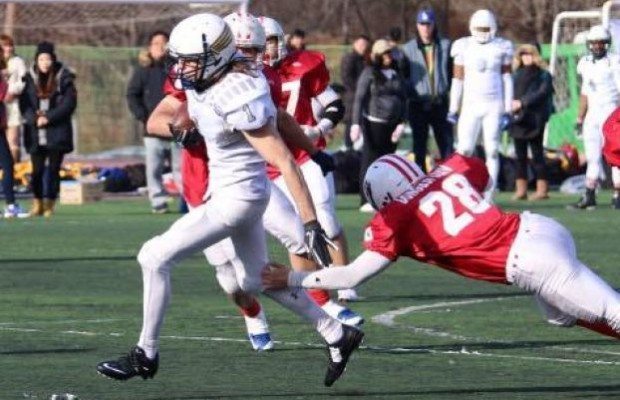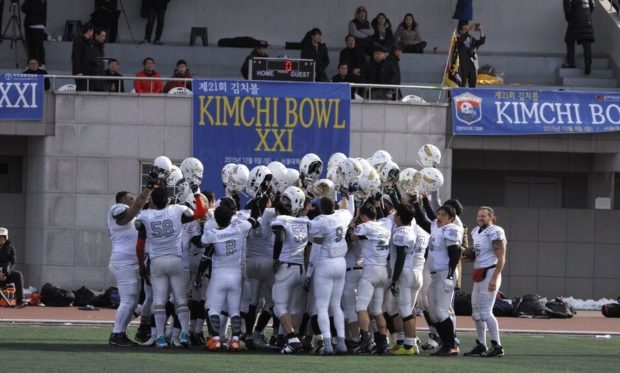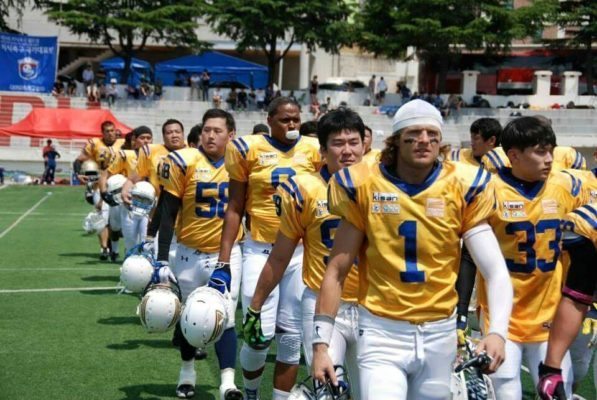The Whole Ten Yards with the Seoul DDP Golden Eagles

Photos: The Korea American Football League, the KNFL and Woon Nala Ko
Gridiron and the Land of the Morning Calm are far from synonymous, despite the impact of former Pittsburgh Steeler Hines Ward. A lack of financing at the high school and university levels leaves under-age sides often at the behest of keen former players when it comes to making ends meet, while at the senior level, the Korean national team suffered straight defeats at the International Federation of American Football (IFAF) World Cup in Canton, Ohio last year. Nevertheless, a nine team senior league playing spring and fall seasons offers a way for both Korean and non-Korean players to compete and build their skills. The desire is there to make the 2016 year one of the best ever for the Korea National Football League (KNFL).
What the league wants now is both the players and the spectators to help it over the goal line.
The Korea American Football Association (KAFA), a non-profit organization that runs both the university league and the KNFL league, also oversees the yearly Kimchi Bowl between the university and fall season KNFL winners. The spring season – seen as an “unofficial” season by the KAFA – has no cap on non-Korean players, which gives new recruits an opportunity to get a few months game time under their belts before the main business of the fall season and the Gwangaetto Bowl title game. The fall season has a 3-player cap on non-Koreans, meaning that only those who have proven themselves can compete for the championship.
The nine teams are divided into Seoul and South divisions, with the top two sides from each division entering the play-off rounds. Most teams are lucky enough to have corporate sponsorship, allowing for financial assistance with travel, training, and some equipment. Over the last few years, bragging rights in Seoul have been passed between the Seoul DDP Golden Eagles and the Seoul Vikings, with the Golden Eagles coming out on top in the season just completed. Down south, Daegu Pheonix and the Samsung Blue Storm have both been successful in the past. The differences between the most successful teams and the also-rans often comes down to passing, with sides that lack a solid quarterback resorting to a running game in order to gain yardage.
Appearances on television – particularly in the run-up to the World Cup – had helped the KNFL to build a nascent following, but with the results not reflecting performances, some at the KAFA may be left wondering if the sport can truly grow. Domestic American football continues to be under-represented in the sports pages, leading to an overall lack of knowledge about the competition. To get more people to pay attention – thereby giving the league the boost that more players and better attendances can offer – the league needs to take things beyond word of mouth. Perhaps, with the right kind of support, 2016 can be the year where gridiron action on the peninsula begins to make some downs.
Just as tiny acorns can form great oaks, Dan Szigeti’s decision to play in a flag football tournament in 2011 led to his involvement in the Korea American Football Association (KAFA) and some of the best times he has had as an expatriate on the peninsula. First with the Seoul Warriors, and more recently with the Seoul DDP Golden Eagles, the Colorado State alumnus has seen championships, MVP awards and even a victory over the Korean national side during his time on the Korean gridiron.
Q: What was your American football background?
Dan Szigeti: Started playing football at the age of 8 through high school. I had some collegiate offers but no scholarships so I decided to put football on hold and go to a big university at Colorado State.
Q: How will the start of the season look?
DS: Our spring training camp will take place in the beginning of April and will probably be at Seoul National University. And our camp in the fall is the first week of August at Point Hwangji Middle School in Taebeck. That will be a sleepover camp where we stay in dorms.
Q: Where are the games played?
DS: Games in Seoul are often played at Simms field on the army base, while the South division venues include either the Samsung ship yard in Geoje-do or a Daegu or Busan University field.
Q: What is the level of competition like?
DS: The level of competition varies considerably. You can have some division talent mixed out there with the Korean who has never really played competitive football. No matter what, you have grown men playing tackle football, the games are played to win, and with great passion.
Q: What is the infrastructure for training like? Is equipment supplied?
DS: We go to Gangwando twice a year for a training camp and then practice 2 to 3 times a week during the season. We have some equipment but there’s a company in Korea from which you can order a custom fit, so most players go that route.
Q: How did your team’s season go? What was the highlight of your season?
DS: We won the championship and beat the national team in the spring so it was a very successful 8 months of football. My personal highlights were being named MVP of both the Gwangaetto Bowl and the game against the national team. I honestly played some of the best football of my life this past year.
Q: Were there any lowlights?
DS: The lowlight is always saying goodbye to the brothers whom you’ve sweat and bled with on the gridiron. You become a family out there, so it’s always hard at the end of the season when some move and others retire.
Q: What is your future in the league? What is your future within American football?
DS: I’m about to be 33, so these might have been my last games, especially with my going out on top. Football takes a serious toll on your body no matter the level, so think it’s time to call it a day. I love football, and if I’m done playing I will be involved in other ways. Either growing the sport here or coaching there, I’m not ready to say goodbye completely quite yet.
Learn more about American football in Korea
KAFA Website (Korean only): https://www.kafa.org/
Seoul Golden Eagles: https://www.facebook.com/groups/184238701623158/?fref=ts
Contact the Seoul Golden Eagles: Gun Choi at 010-3510-1090
This article originally appeared in Groove Korea magazine: https://groovekorea.com/article/the-whole-ten-yards/#

